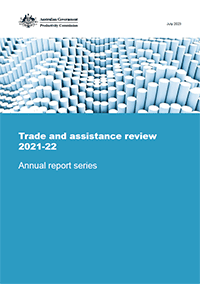Trade and Assistance Review 2021-22

Annual report series
The Trade and Assistance Review (TAR) contains the Commission’s latest quantitative estimates of Australian Government assistance to industry, and provides a summary of developments in industry assistance, trade policy and foreign investment over the past year.
Trade and assistance review exposes rising industry assistance
Assistance to Australian industry – money spent by governments to support Australian businesses – rose to $13.8 billion in 2021-22, according to the Productivity Commission’s annual Trade and Assistance Review (TAR) released today.
The 49th TAR examines the increasingly opaque government subsidies and concessions, which increased by $460 million over the previous year.
“The TAR is an important transparency document and is a vital resource for understanding how governments are using taxpayers’ money to support private businesses,” said Deputy Chair Dr Alex Robson.
The rise in industry assistance comes amid a global return to overt industry policy, as fears about supply chain disruptions continue.
“The world’s largest economies are increasingly engaged in policies to favour selected domestic industries through subsidies, local content rules and trade barriers. In many cases this is simply a form of old-fashioned protectionism.”
“As a small open economy, our future prosperity depends on global economic integration and low trade barriers. It is unlikely to be in Australia’s interests to try and compete in a protectionist contest via large scale industry assistance,” said Dr Robson.
Whereas past industry assistance mainly took the form of tariffs, this year’s TAR shows that most assistance now comes from ‘behind the border’ measures such as tax concessions and government spending.
The main effect of Australia’s complex and convoluted tariff system is to impose ‘nuisance’ compliance costs on importers. The TAR estimates these costs – much of which are likely to be passed on to households – were between $1.2 and $3.6 billion in 2021-22, compared to tariff revenue of $1.8 billion.
“For every $1 in revenue raised by tariffs, between $0.67 and $2.00 is lost in economic activity. Our tariff system imposes unnecessary costs and hurts consumers, and does not protect domestic industry,” said Dr Robson.
The 2021-22 TAR also explores two growing sources of industry assistance: concessional finance from government-owned entities and climate change measures that are not achieving our emissions reduction objectives at lowest cost.
Concessional finance – where governments provide finance at favourable interest rates to industry – is particularly challenging to evaluate, given that not all government-owned financing entities report the value of their concessional loan charges.
“This year’s TAR establishes a framework to estimate the cost of these arrangements to taxpayers. Better estimates could be made if all entities published the credit rating of their loan portfolio and their concessional loan discount expenses,” said Dr Robson.
The TAR also analyses Australia’s complex structure of carbon abatement policies to assess whether they are reducing emissions at least cost.
“Grants and concessions can play a role in supporting emissions reductions. But they also deploy taxpayers’ money to support private businesses, so transparency is important,” said Dr Robson.
The Trade and Assistance Review 2021-22 can be found at www.pc.gov.au.
Media requests
Media team – 02 6240 3330 / media@pc.gov.au
Preliminaries: Cover, Copyright and publication detail, Foreword, Acknowledgements and Contents
Executive summary
- Estimates of assistance and costs
- A closer look at budgetary assistance
- A new framework for monitoring the effects of tariffs
- Industry assistance developments
- Endurance of ‘temporary’ COVID-19-related assistance
- How Australian climate policy might act as a form of industry assistance
- Concessional finance
- Trade policy developments
- Australia’s trade environment has continued to recover from recent disruptions
- WTO dispute issues persist, but some progress has been made in bilateral trade agreements
- Globalisation is not dead
- A resurgence in major economy industry policy
- Update on carbon border tariffs
- Foreign investment policy developments
- Foreign investment developments
- Developments in foreign investment policy
- Foreign direct investment applications
- A new framework for monitoring the effects of tariffs
- Analysing Australian responses to the US Inflation Reduction Act
- B.1 Industry policy developments in the major economies
- B.2 Potential Australian responses to major economy industry policy
- B.3 Possible further erosion of the rules-based global trading system
- Adjustments to trade disruptions
- Trade policy disruptions
- The broader impacts of coercive trade measures
- Assistance estimates (available online above)
Abbreviations
References
Printed copies of this report can be purchased from Canprint Communications.
We value your comments about this publication and encourage you to provide feedback.


